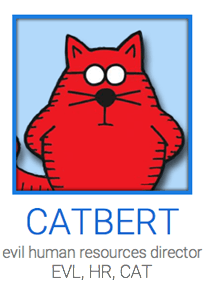Business Correspondence Project (BCP)
Project Description & Overview
Correspondence is the foundation of business communication. In careers across the disciplines, correspondence such as memos, emails, and letters make up the majority of documents professionals produce during their employment. In class, we will discuss contexts/purposes for writing (positive/neutral, negative/bad news, and persuasive), short correspondence genres (memos, emails, and letters), and strategies for communicating effectively within them. Ultimately, this project will ask you to plan for (PAGOS), draft, and revise positive/neutral, negative, and persuasive professional correspondence.
Feedback Teams & Scenarios
You will be divided into writing teams of three or four. Each student in the team will be assigned a persona—Dilbert, Catbert, Dogbert, or Alice—and this persona will determine the specific scenarios the student must for in order to compose documents for Project 1.
While you will be divided into “feedback teams” and are expected to collaborate, this isn’t a collaborative project (per se). You are expected to collaborate—conscientiously participate in planning, peer review, critique, and workshops. While you will offer ideas for improving team members’ correspondence, ultimately, each individual is responsible for the documents she or he was assigned. In other words, you will not receive a group grade; you will receive an individual grade on the documents you submit.
Planning, Drafting, and Peer Review Participation
In order to fully and conscientiously participate in brainstorming, planning, and peer review of all team members’ documents, you must be familiar with all of the scenarios – not just the ones you are assigned.
At times, you will be required to print copies of your document plans/drafts for your group. You may also be asked to submit electronic copies so I can monitor participation, but you will not receive instructor feedback on these uploaded copies. There will be a due date for draft submission for instructor comment after team/peer review. Due dates and guidelines for peer review drafts will be clearly noted on the course schedule.
Expectations:
 In general, you are expected to employ strategies you’ve learned from course material during the semester. Specifically, you are expected to
In general, you are expected to employ strategies you’ve learned from course material during the semester. Specifically, you are expected to
- Create thorough PAGOS Document Plans.
- Briefly, this means considering immediate and longer term/overall purposes (i.e., what do you want to have happen immediately as a result of this communication situation? what do you want to have happen eventually as a result of this communication situation?), the information you need to provide to accomplish your purposes, etc. It means considering primary and secondary audiences (including initial, gatekeeper, watchdog, etc.), their background, demographics, what they know/need to know, how the are likely to react to the message, the context in which they might receive the message, etc.
- After you create plans, use those plans to guide your decisions about how and what to write in your correspondence.
- Use reader-centered writing and you attitude, with special considerations for negative situations/information, reader benefits, etc.
- Write with the goals of professional writing in mind:
- Clarity – Be clear about your reason for writing, what you want to have happen, what you want the audience to do, etc.
- Correctness – Writing should be factually and grammatically correct.
- Conciseness – Use strategies for concise writing.
- Write, organize, and format documents according to the conventions of their genre and purpose. In other words, letters should look like letters, memos should look like memos, and emails should look like emails.
- Write good subject lines for memos, emails, and if you decide, for letters.
- For writing emails, write the document in a word processing file — just remember to include all of the necessary fields (To Name/Address, From Name/Address, Subject) and additional fields if desired (Cc, Bcc, Attachments).
- Conscientiously participate in peer review by offering your feedback team members constructive criticism and helpful suggestions.
- Engage in careful, critical revision of your own work before submitting your documents for grading.
Additional Guidelines
Make conscious decisions about everything, particularly genre, organization, and style (these three elements of PAGOS plans are those most often overlooked). Also, on your PAGOS plans, be sure to indicate why you made the choices you did.
Be selective about the information you include in your correspondence. Omit unnecessary/ irrelevant information, but be sure to include enough information to achieve your purpose.
You may make up information/details (such as an end date for action, if one is not provided) to add to your correspondence if you feel it is necessary. However, any additional information/details must not significantly change the context/scenario and must be noted in your document plan(s).
If you are writing as the representative of a company, you may create a very simple letterhead, but it is not required.
Documents should be formatted according to the conventions of its genre. In other words, letters should look like letters, memos should look like memos, etc.
For emails, type the document in a word processing file — just remember to include all of the necessary fields (To Address, From Address, Subject, CC, BCC, Attachments).
Final Submission Guidelines
The due date for final project submission will be listed on the course schedule. Please copy/paste your PAGOS plans, drafts, and final drafts into ONE FILE. Save as a .doc/x file as filename “P1-Final” and upload to TBA.
Each document should fall on a separate page, roughly, in this order:
Positive/Neutral PAGOS Plan
Positive/Neutral Draft(s)*
Positive/Neutral Final
Negative PAGOS Plan
Negative Draft(s)*
Negative Final
Persuasive PAGOS Plan
Persuasive Draft(s)*
Persuasive Final
*I expect each student should have at least one draft for each piece of correspondence (you are encouraged to submit more than one). You may any/all drafts in your file. Alternately/additionally, if you have any hand-marked copies of peer review notes or hand-edited/reviewed drafts, you may submit paper copies them in during class on the project due date.
Please clearly label the tops of documents with “Plan,” “Draft,” and “Final” (if you have two or more drafts for any of the correspondence pieces, label them appropriately, i.e., “Workshopped Draft,” “Draft 2,” etc.).
If there are any hand-marked copies of peer review notes or hand-edited/hand-marked drafts, you may hand them in during class on the project due date.
Evaluation & Assessment
A Range
Work considered ‘A’ range meets and exceeds all of the tenants of good professional writing.
‘A’ range final documents
- [purpose] Achieves a clear, appropriate purpose, usually to inform, request, or persuade; includes information needed to accomplish purpose with no extraneous or unimportant details; information is clear and correct.
- [audience] Addresses primary audience; considers audience’s demographic background, position, etc.; emphasizes reader benefits and addresses possible drawbacks/objections; demonstrates awareness of audience members’ needs, wants, values, expectations, and potential reactions; considers the context/situation where audience might read the message; also considers possible secondary audiences, including their backgrounds and contexts.
- [genre] Is consciously written in an appropriate genre; adheres to genre conventions with no formatting errors.
- [organization] Employs clear, logical direct or indirect organization appropriate for purpose and genre; if positive or neutral, front loads main idea and important information; for negative, includes buffer and employs BEBE method; for persuasive, demonstrates understanding of audience values and interest; for all purposes, communicates goodwill and includes a call to action if necessary.
- [style] Employs a clear, correct, concise professional writing style; employs reader-centered writing with positive emphasis, you-attitude (you-view), and emphasis on reader benefits; words and sentences are familiar to the audience; writing is readable with no “business-ese” or canned phrases; correctly employs active and passive verbs; uses bullets and/or graphic highlighting as appropriate.
In addition, ‘A’ range work is virtually free of grammatical, typographical, and spelling errors.
B Range
Work considered ‘B’ range adheres to most of the tenants of good professional writing.
‘B’ range final documents
- Show evidence of a clear, appropriate purpose. Document includes nearly all of the necessary information needed to accomplish purpose. Information is accurate.
- Address primary audience, and considers audience’s background and/or context. Document considers possible secondary audiences.
- Adhere to the conventions of an appropriate genre. Documents may have a few formatting errors or may deviate from genre conventions in minor ways.
- Employ logical organization. Document includes buffers or “good news” as appropriate.
- Employ professional style. Document may a few minor several stylistic errors. Document employs positive tone, you-attitude, and/or emphasizes reader benefits. Document may have a few instances of wordiness, lack of clarity, and may employ a few words or phrases inappropriate to the audience.
In addition, ‘B’ range work may contain a few grammatical errors that do not interfere with readability and usability. Errors in B range work will not impede overall meaning.
C Range
Work considered ‘C’ range attempts to adhere to the tenants of good professional writing.
‘C’ range final documents may
- Show evidence of a purpose, but may be unclear in places. Document may fail include some necessary information needed to accomplish purpose or information may be inaccurate or unclear.
- Address primary audience, but fail consider the audience’s background and/or context. Also, document may not consider secondary audience(s).
- Attempt adherence to the conventions of genre. Genre choice may be inappropriate and/or document may not include all elements of genre. Documents may have formatting errors.
- Attempt to employ logical organization. May not include buffer or “good news” in appropriate location.
- Attempt to employ professional style. Document attempts to demonstrate an appropriate professional ethos, but may have several instances where positive tone, you-attitude, and/or emphasis on reader benefits are ignored. Document may have several instances of wordiness, lack of clarity, and may employ words or phrases inappropriate to the audience.
In addition, ‘C’ range work may contain repeated and significant grammatical errors that interfere somewhat with readability and usability. However, errors in ‘C’ range work will not impede overall meaning and will not make documents difficult to understand.
D-F Range
Work considered ‘D-F’ range does not adhere to the tenants of good professional writing.
‘D-F’ range final documents may
- Lack clear purpose or may fail to include the necessary information needed to accomplish a purpose.
- Fail to address a primary audience, fail consider the audience’s background and/or context.
- Not adhere to the conventions of an appropriate genre
- Lack clear, logical organization.
- Fail to employ an appropriate professional style. Document does not express an appropriate professional ethos, without regard to positive tone, you-attitude, and/or emphasis on reader benefits. Document may have many instances of wordiness, lack of clarity, and employs words or phrases inappropriate to the audience.
In addition, ‘D-F’ range work may contain repeated and significant grammatical errors that interfere with readability and usability, including those that impede meaning and/or make documents difficult to understand.
A Note on Plagiarism
If any document submitted for Project 1 is found to be plagiarized, in whole or in part, you will receive a 0% F for the project. At the instructor’s discretion, plagiarism can result in a 0% F for the semester grade and a permanent note on the student’s transcript. Repeated cases of plagiarism may result in expulsion from the university. Please refer to the University Honor Code in the University Catalogue for more information.








